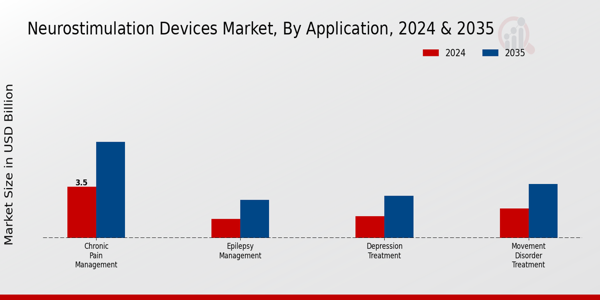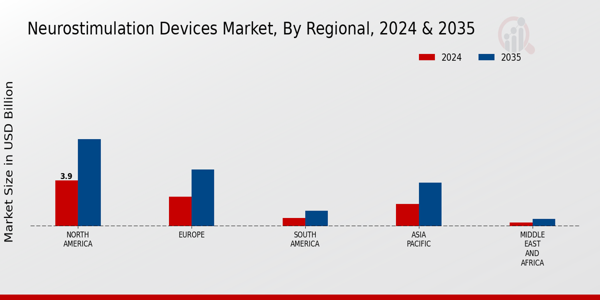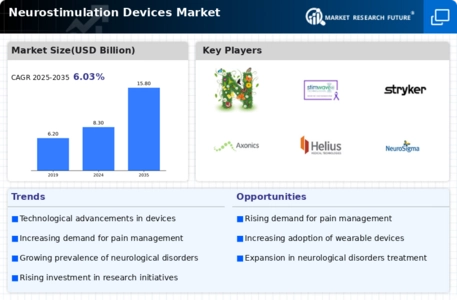The Neurostimulation Devices Market has seen multiple developments recently, particularly with innovations in technologies and products by key players. Axonics has gained considerable traction in the sacral neuromodulation (SNM) segment. In March 2024, the company obtained CE Mark approval for its Axonics R20 rechargeable SNM system in Europe. In January 2024, Medtronic received FDA approval for its Percept™ RC neurostimulator, which integrates BrainSense™ technology, enabling real-time neural activity tracking for more personalized deep brain stimulation (DBS) therapy.
Market valuations have surged, with companies like Stimwave experiencing increased interest from investors, reflecting a broader trend towards non-invasive treatment options. Additionally, NeuroSigma received attention for its non-invasive neuromodulation devices that treat epilepsy, marking a significant step forward in the clinical landscape. Over the past 2-3 years, there has been a marked increase in market focus on neurostimulation solutions, emphasized by enhanced regulatory support and favorable reimbursement policies across various regions globally.
Neurostimulation Devices Market Drivers
Rising Prevalence of Neurological Disorders
The Neurostimulation Devices Market Industry is significantly driven by the increasing prevalence of neurological disorders such as epilepsy, Parkinson's disease, and chronic pain. According to the World Health Organization (WHO), approximately 1 in 6 people worldwide will experience a neurological disorder at some point in their life. Moreover, according to estimates, the number of people living with dementia is projected to reach 78 million by 2030.This rising number of patients presents a growing demand for neurostimulation devices, as healthcare providers seek effective management solutions.
Major companies such as Medtronic and Boston Scientific are investing heavily in Research and Development to innovate and expand their product line to address this growing market need. As such, the continuous rise in neurological disorder cases and the constant advancements in neurostimulation technology are pivotal drivers of market growth.
Technological Advancements in Neurostimulation Devices
Technological advancements play a crucial role in propelling the Neurostimulation Devices Market Industry forward. Innovations such as miniaturization of devices, wireless technology, and advanced software for programming and monitoring have changed the dynamics in neurostimulation solutions. The introduction of adaptive neurostimulation devices, which can automatically adjust stimulation parameters based on real-time feedback received from body signals, showcases the rapid evolution of this technology.Industry leaders such as Abbott Laboratories have been trailblazers in developing advanced neurostimulation technologies that enhance patient outcomes.
The ongoing investments in Research and Development and partnerships among major players to innovate and bring new technologies to market ensure a continuous growth trajectory for this industry.
Increasing Geriatric Population
As global demographics shift, the increasing geriatric population is significantly influencing the Neurostimulation Devices Market Industry. According to United Nations projections, the number of older persons (aged 65 years or over) is expected to double from 703 million in 2019 to 1.5 billion by 2050. This demographic is often predisposed to neurological disorders and chronic pain, thus driving demand for neurostimulation devices as effective therapeutic options.Organizations such as the American Geriatrics Society emphasize the importance of proactive health management, thereby increasing interest in neurostimulation treatments among healthcare providers catering to older populations.
Therefore, the escalating geriatric demographic directly contributes to market growth as the demand for improved healthcare solutions rises.
Neurostimulation Devices Market Segment Insights
Neurostimulation Devices Market Application Insights
Among the different applications, Chronic Pain Management holds a substantial portion of the market, valued at 3.5 USD Billion in 2024 and projected to grow to 6.6 USD Billion by 2035. This application segment is vital as chronic pain conditions affect millions globally, necessitating the adoption of effective neurostimulation solutions to provide relief and reduce reliance on medications.Following closely is the Movement Disorder Treatment segment, which is valued at 2.0 USD Billion in 2024 and is expected to grow to 3.7 USD Billion by 2035.
This segment's significance is underscored by the rising prevalence of disorders such as Parkinson's disease, where neurostimulation devices can effectively mitigate symptoms and improve mobility. Furthermore, Depression Treatment, valued at 1.5 USD Billion in 2024 and forecasted to increase to 2.9 USD Billion by 2035, is an important area of focus, as mental health issues become more recognized and prioritized in health care systems worldwide.Neurostimulation devices offer promising alternatives for patients who do not respond to traditional pharmacological interventions.
Additionally, the Epilepsy Management segment, which stands at 1.3 USD Billion in 2024 and is projected to rise to 2.6 USD Billion by 2035, highlights the need for innovative treatments for seizure control, addressing a significant portion of the global population affected by epilepsy.
Overall, the growth drivers in these application areas include advances in technology, increasing investment in Research and Development, rising adoption of neurotechnologies, and a greater understanding of the underlying mechanisms of neurological and psychiatric disorders.The positive trend in the Neurostimulation Devices Market data reflects the demand for effective management of diverse health conditions, while the opportunities within each application area help address the unmet needs in patient care. The segmentation of the Neurostimulation Devices Market provides in-depth insights into tailoring product offerings and strategies, ensuring that manufacturers remain attuned to evolving patient and market demands.
Market statistics reinforce the continuing importance of these applications, driving further innovation and potential market growth.

Source: Primary Research, Secondary Research, Market Research Future Database and Analyst Review
Neurostimulation Devices Market Product Type Insights
The Neurostimulation Devices Market is categorized by various product types that play a crucial role in addressing neurological disorders and pain management. Among these, spinal cord stimulators, deep brain stimulators, transcranial magnetic stimulators, and vagus nerve stimulators are significant contributors to market dynamics. In 2024, the Neurostimulation Devices Market revenue is projected to reach 8.3 billion USD, reflecting a growing demand for effective therapeutic solutions.
Spinal cord stimulators have become particularly important for managing chronic pain, helping to improve the quality of life for numerous patients.Deep brain stimulators, on the other hand, are vital in treating conditions such as Parkinson's disease, with their capacity to enhance motor function being a key driving factor. Transcranial magnetic stimulators are increasingly recognized for their ability to facilitate treatment in various mental health conditions, marking a revolutionary approach in psychiatry. Vagus nerve stimulators are gaining traction for treating epilepsy and depression, showcasing their potential in innovative therapeutic strategies.
Overall, the segmentation within the Neurostimulation Devices Market showcases not only the diversity of treatment options but also highlights the significant growth potential this industry possesses in aligning with global health trends.
Neurostimulation Devices Market End User Insights
The Neurostimulation Devices Market, driven by various end users, is experiencing significant growth. Hospitals are a primary end user, often investing in advanced neurostimulation technologies to enhance patient care and manage chronic pain and neurological disorders. Specialty clinics also play a crucial role, offering targeted treatments and specialized services that contribute to the market's expansion.Additionally, home care settings are gaining traction as patients increasingly seek convenient treatment options in the comfort of their homes, driven by technological advancements and a growing emphasis on personalized healthcare solutions.
The market is characterized by a consistent global increase in demand, supported by trends in patient-centered care, the rise of chronic conditions, and the increasing adoption of minimally invasive surgical techniques. Furthermore, challenges such as regulatory hurdles and the high cost of devices create opportunities for innovation in product development, aiming to enhance accessibility and affordability of neurostimulation therapies.With the Neurostimulation Devices Market expected to reach a value of 15.8 billion USD by 2035, this segment presents significant dynamism and potential for continued growth.
Neurostimulation Devices Market Technology Insights
The Neurostimulation Devices Market, with a strong emphasis on the Technology segment, is witnessing significant advancements that are reshaping healthcare. Within the Technology landscape, methods like Electrical Stimulation, Magnetic Stimulation, and Chemical Stimulation play crucial roles. Electrical Stimulation is essential for pain management and neurological disorders, utilizing electrical impulses to facilitate nerve function.Magnetic Stimulation employs non-invasive techniques to influence neuronal activity, making it an attractive option in treatment plans for conditions such as depression and migraines. Meanwhile, Chemical Stimulation, often tied to pharmacological approaches, provides targeted treatment options that enhance therapeutic efficacy.
Collectively, these technologies not only support the Neurostimulation Devices Market industry but also appear to drive market growth through their diverse applications. Market trends highlight a growing preference for minimally invasive techniques and advancements in technology that enhance device efficiency and patient outcomes, marking the Technology segment as a dynamic and integral component of the Neurostimulation Devices Market landscape.
Neurostimulation Devices Market Regional Insights
The Neurostimulation Devices Market is projected to experience notable growth across various regions. In 2024, North America leads the market with a valuation of 3.9 USD Billion, reflecting its significance due to advanced healthcare infrastructure and rising neurological disorders. Europe follows closely, valued at 2.5 USD Billion, driven by increasing Research and Development activities and favorable government policies.
Asia Pacific holds a valuation of 1.9 USD Billion, fueled by a growing elderly population and rising awareness of neurostimulation therapies.South America, with a market worth of 0.7 USD Billion, is gradually adopting these technologies, while the Middle East and Africa represent a nascent market at 0.3 USD Billion, facing challenges such as limited access to advanced healthcare systems. The regional dynamics indicate North America's dominant position in the Neurostimulation Devices Market revenue, establishing itself as a major player driven by higher expenditure in healthcare.
The continual advancements in technology and increasing investment are expected to further boost the Neurostimulation Devices Market statistics in the upcoming years.Each region's unique characteristics and requirements suggest opportunities for growth and innovation tailored to specific populations, enhancing the overall market growth trajectory.

Source: Primary Research, Secondary Research, Market Research Future Database and Analyst Review















Leave a Comment